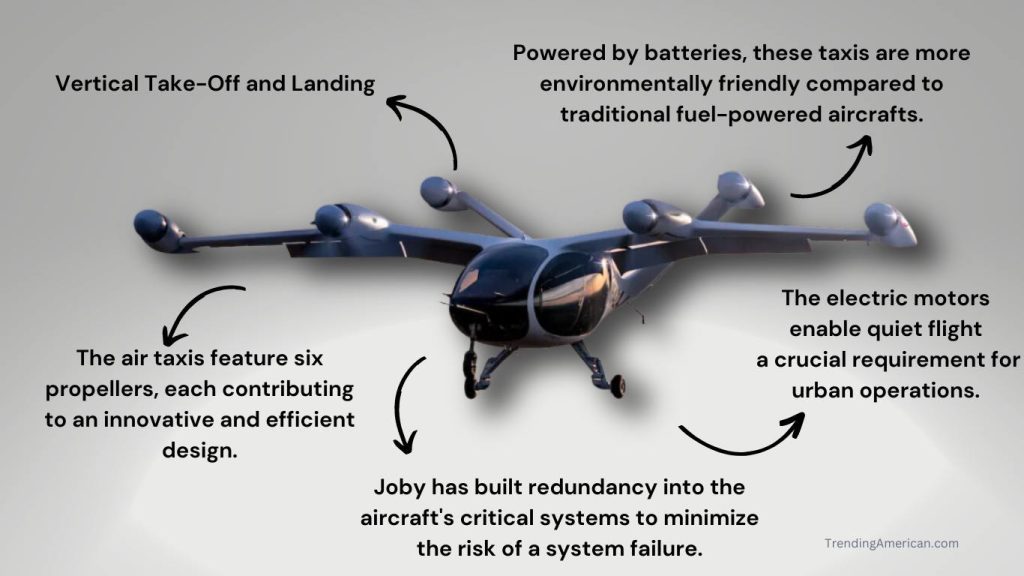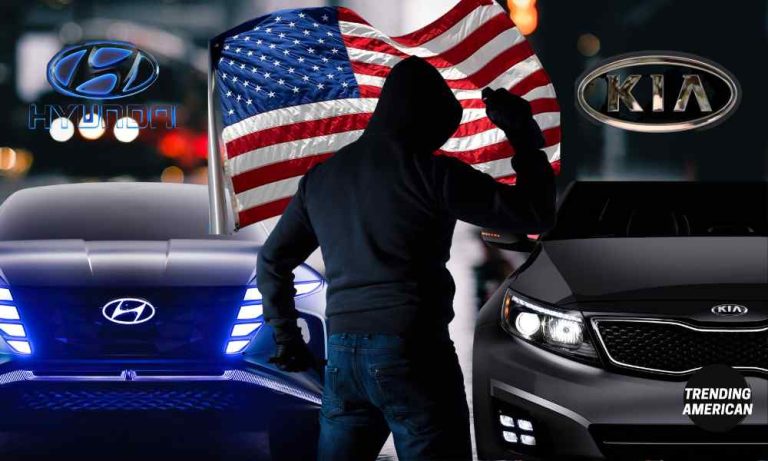Joby’s Electric Flying Taxis: Gets clearance for flying in the US
Imagine a world where you can soar above traffic in a quiet, electric flying taxi. This may soon become a reality, thanks to companies like Joby Aviation. Joby Aviation is making significant strides in the development of electric air taxis, bringing us closer to a future of sustainable, urban air mobility.
Joby’s electric aircraft is an innovative engineering marvel, featuring six propellers, each over six feet in diameter, designed to take off and land vertically like a helicopter. With its ability to complete a 150-mile flight on a single charge, the company’s electric air taxi promises to revolutionize the way we travel in densely populated areas, reducing congestion and emissions from traditional modes of transportation.

Joby gets the clearance for flight tests in the US
Joby Aviation, a California-based company, is working on developing electric flying taxis that are expected to revolutionize urban transportation. Their electric vertical take-off and landing (eVTOL) aircraft has recently received approval for flight testing from the Federal Aviation Administration (FAA), inching closer to becoming a reality.

Joby’s Electric Flying Taxi Overview
The innovative flying taxi aims to offer an alternative to conventional ground transportation services like Ola and Uber. By reducing traffic congestion and decreasing travel time, these taxis could transform how people commute in densely populated cities.
Joby’s electric flying taxi features a unique design with six electric motors that enable vertical take-off and landing, making it easier to navigate urban environments. In addition, the vehicle boasts a top speed of over 200 miles per hour and can fly up to 150 miles on a single charge, providing a significant advantage over traditional transportation methods in terms of speed and range.
Being environmentally friendly, Joby’s flying taxis produce no emissions during operation, making them a sustainable transportation option. The company is on track for commercial operations starting in 2025, which could positively impact urban mobility and contribute to reduced carbon emissions in cities.
To sum it up, Joby Aviation is making significant progress in developing its electric flying taxi. With the FAA’s approval for flight testing and plans for commercial operations in the near future, this innovative transportation solution holds great promise for transforming urban commutes while promoting sustainability.
How It Works

Power and Propulsion
Joby’s electric flying taxis use eVTOL (electric vertical takeoff and landing) technology, which allows them to take off and land much like a helicopter, without requiring a runway. This makes them ideal for short, point-to-point trips in densely populated urban areas 1. Joby Aviation’s aircraft features six propellers, each contributing to its efficient and innovative design 2.
These electric air taxis are powered by batteries, making them more environmentally friendly compared to traditional fuel-powered aircraft. The electric motors enable quiet and efficient flight, which is crucial for operating in urban settings.
Safety Features
Joby Aviation has put significant effort into ensuring the safety of its electric flying taxis. Some of the key safety features include redundancy in the aircraft’s critical systems, which helps minimize the risk of a system failure impacting the flight.
Moreover, the aircraft undergoes rigorous testing and will need to meet the standards set by aviation authorities, such as the Federal Aviation Administration (FAA), before it can be commercially launched 3.
By incorporating these safety features and adhering to strict regulatory guidelines, Joby aims to make electric air taxis a reliable and practical mode of urban transportation in the future.
Performance and Passengers
Speed and Range
Joby Aviation’s electric air taxi is designed for efficiency and distance. Capable of reaching top speeds of up to 200 mph, it boasts an impressive range of 150 miles, making it ideal for urban commutes and regional trips. This eVTOL (electric vertical take-off and landing) aircraft is not only fast but also environmentally friendly, relying on clean electric power to soar through the skies.
Capacity and Comfort
The future of urban air travel not only focuses on speed but also on passenger capacity and comfort. Joby’s eVTOL is designed to accommodate up to five passengers, providing a comfortable and spacious cabin for people to travel together. The aircraft features six large propellers, each more than 6 feet in diameter, enabling a smooth and stable flight experience. Furthermore, Joby’s commitment to reducing noise pollution ensures that the ride is not only comfortable but also quiet, making it an attractive option for those seeking a more enjoyable and sustainable mode of transportation.
Infrastructure and Deployment
As the world moves towards more environmentally friendly transportation solutions, Joby Aviation is at the forefront of the revolution with its electric flying taxis. In this section, we will explore the infrastructure and deployment of these taxis, focusing on charging and maintenance, as well as air traffic management.
Charging and Maintenance
To ensure smooth operation of their electric flying taxis, Joby Aviation has developed efficient methods for both charging and maintaining their eVTOL vehicles. A notable accomplishment for the company was when the flying taxi prototype successfully completed a 150-mile flight on a single battery charge. This achievement demonstrates the viability of electric flying taxis for short to medium-range trips.
Charging infrastructure for electric flying taxis will need to be established at takeoff and landing sites. This might include rapid chargers to minimize downtime between flights and dedicated areas for battery swapping. Maintenance facilities will likewise be necessary for ensuring the eVTOL vehicles are kept in optimal working condition and meet all required safety regulations.
Air Traffic Management
In order for electric flying taxis to become a practical and safe option for urban transportation, an effective air traffic management system must be put in place. This is especially important as eVTOL vehicles like Joby’s flying taxi are designed to operate at altitudes between 1,000 and 2,000 feet, with speeds of 150 to 200 miles per hour.
Air traffic management for flying taxis will require the development and integration of new technologies, such as drone traffic management systems and automated flight controllers. Collaboration between regulatory authorities, such as the Federal Aviation Administration (FAA) and the European Aviation Safety Agency (EASA), will be crucial in establishing standardized procedures and guidelines for the operation of eVTOL transport vehicles.
In summary, infrastructure and deployment are key factors to consider when discussing the future of electric flying taxis like the ones developed by Joby Aviation. By addressing charging and maintenance concerns, as well as establishing a robust air traffic management system, these taxis have the potential to revolutionize urban transportation and help reduce our carbon footprint.
Regulation and Certification
Joby Aviation, a California-based company, has been developing electric vertical takeoff and landing (eVTOL) aircraft for potential commercial passenger services. To legally operate these innovative flying taxis, Joby has to comply with certain certification and safety regulations.
FAA Approval
In May 2022, Joby Aviation received a Part 135 Air Carrier Certificate from the Federal Aviation Administration (FAA), allowing them to move forward in their pursuit of offering on-demand commercial air taxi operations. This FAA certification marks a significant milestone for the company.
Since obtaining the Part 135 Certificate, Joby has been working tirelessly to achieve further regulatory approval. As part of the ongoing certification process, the company aims to have its eVTOL air taxi certified by 2023, with commercial operations expected to begin in 2024.
International Standards
While advancements in FAA regulations are crucial for Joby’s growth in the United States, obtaining international certifications is essential for global adoption of eVTOL air taxis. Although specific international standards have yet to be established for electric flying taxis, the ongoing success of Joby Aviation demonstrates the increasing attention given to the regulatory landscape surrounding this emerging technology.
In summary, the regulation and certification process for Joby’s electric flying taxis is moving forward, both nationally and internationally. While plenty of work lies ahead for Joby Aviation, they have already made notable progress in this evolving industry.
Potential Impact and Market
Urban Mobility
Joby’s electric flying taxis aim to revolutionize urban mobility by providing faster and more efficient transportation options. Their air taxis have a top cruise speed of 200 mph and a range of 150 miles, making them suitable for commuting within and between cities. This new mode of transport could significantly reduce congestion on roads and shorten travel times, allowing people to live further from city centers without compromising their access to work and amenities.
Environmental Benefits
Electric air taxis, such as those being developed by Joby, offer considerable environmental benefits. First and foremost, they produce zero emissions during operation, as they run on battery power. This could potentially help cities meet their carbon reduction targets and improve air quality. Furthermore, electric flying taxis can reduce overall noise pollution since they are designed to be quiet during flight, contributing to a more pleasant urban environment.
In addition to reducing emissions and noise, Joby’s air taxis may lead to more sustainable land use. By providing an alternative mode of transport, urban planners can allocate less space for traditional road infrastructure, freeing up land for green spaces or other communal uses.
Joby’s flying taxis have made significant strides toward commercialization, with the company receiving US regulatory approval to expand testing. As this technology advances, it shows promise for disrupting current transportation systems and making cities more sustainable, efficient, and connected.
Competitors and Industry Landscape
The electric flying taxi industry is quickly evolving, bringing new players and technology into the fold. Joby Aviation is making headlines with its innovative electric vertical takeoff and landing (eVTOL) aircraft, and the company recently received US regulatory approval to expand testing of its air taxi. However, Joby faces stiff competition from various companies eyeing the highly anticipated air mobility market.
Airbus is one such competitor, having showcased their concept for an autonomous flying taxi called Vahana. This single-seat electric aircraft aims to reduce urban congestion and reach underserved locations. With the backing of a major aviation company, Airbus is well-equipped to make a significant impact in the eVTOL market.
Volocopter is a German startup specializing in electric air taxis. Having conducted numerous successful test flights, the company is working towards commercializing their 2X model – a fully electric, 18-rotor aircraft that boasts an impressive design and significant safety features. They are currently targeting roll-out within the next few years.
Ehang is a Chinese company that continues to push the boundaries of air mobility, showcasing their eVTOL prototype called Ehang 216. This passenger drone has already conducted test flights and offers an alternative means of transportation for both urban and intercity travel.
Despite facing competition, Joby Aviation has made significant strides in the industry. They recently announced plans to build a major manufacturing facility in Covington, Georgia, with the goal of producing up to 650 aircraft per year. In addition, Joby has formed a partnership with ANA, Japan’s largest airline, in an effort to bring flying taxis to Japan.
The industry landscape for electric flying taxis is highly competitive, with numerous companies working on advanced air mobility solutions. As this sector continues to grow, we can expect to see further advancements in technology, design, and safety features that will ultimately reshape urban transportation.
Conclusion
In the world of urban mobility, Joby Aviation’s electric flying taxis have the potential to transform the way people move within and between cities. With their electric vertical takeoff and landing aircraft (eVTOL), these taxis could offer efficient and environmentally friendly alternatives to traditional ground transportation.
The technology behind Joby’s flying taxis is impressive, featuring six propellers that allow for vertical takeoff and landing, making them ideal for urban environments. According to the BBC, commercial flights could become a reality by 2024, giving commuters and travelers a new mode of transportation to look forward to.
One significant achievement by Joby Aviation is the completion of a 150-mile test flight with their eVTOL. This shows the viability of their technology for longer distances and paves the way for further advancements in the industry.
However, it’s important to remember that there are still regulatory and safety hurdles to overcome before flying taxis become a common sight in urban skies. Collaboration between aviation companies, regulatory bodies, and governments will be essential to ensure a smooth and safe integration of electric flying taxis into the transportation ecosystem.
As we look forward to the future of urban mobility, Joby Aviation’s electric flying taxis stand out as an exciting and promising development. Embracing this technology could significantly reduce traffic congestion and carbon emissions while providing a new, efficient mode of transportation for people living in crowded cities.
Frequently Asked Questions
Joby Aviation’s electric flying taxis are designed to offer a sustainable and efficient mode of transportation. They feature a six-rotor aircraft with electric vertical takeoff and landing (eVTOL) capabilities, allowing them to operate in urban environments with minimal noise and emissions. In addition, their sleek design and advanced technology contribute to safety and ease of use. Joby’s electric aircraft aims to democratize air travel, making it more accessible and affordable.
While there are several companies working on developing eVTOL aircraft, Joby Aviation is a prominent player in the industry. The company’s progress has been notable, with accomplishments such as a 150-mile flight of its electric air taxi. As they continue to work on certification and commercialization, Joby’s commitment to safety, sustainability, and affordability sets them apart from competitors.
Joby’s S4 electric aircraft is designed to have a range of up to 150 miles, as demonstrated in a recent test flight. Its top speed is not explicitly mentioned, but the aircraft prioritizes efficiency and environmental sustainability. The extended range and focus on eco-friendly design make it a promising option for various transportation needs.
Joby Aviation’s headquarters and facilities are located in Northern California. The company is dedicated to eVTOL technology development and innovation, with their facilities featuring cutting-edge resources to help bring their vision of sustainable air transportation to fruition.
Joby Aviation has attracted investments from various sources to support its vision of eco-friendly air taxis. Some notable investors include Intel, Toyota AI Ventures, and JetBlue Technology Ventures. This diverse group of investors showcases confidence in Joby Aviation’s potential to impact the future of transportation.
There is no specific price disclosed for Joby’s eVTOL aircraft, as the company is still in the development and certification stages. However, Joby Aviation’s goal is to make air commuting as affordable as possible, with a strong focus on accessibility to a wide range of users. In the future, they aim to offer competitive pricing that encounters today’s transportation methods.







